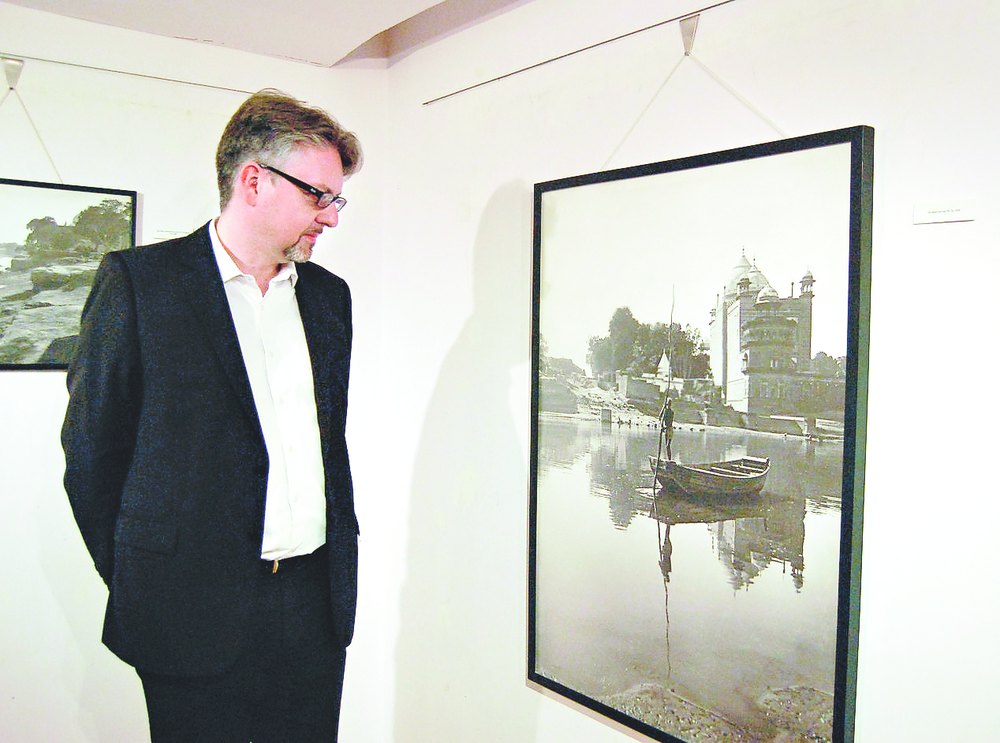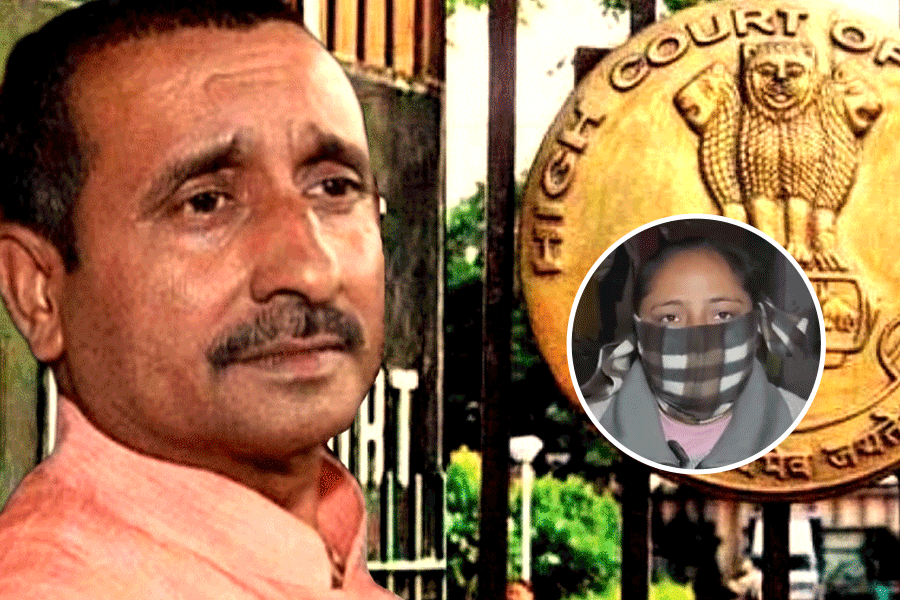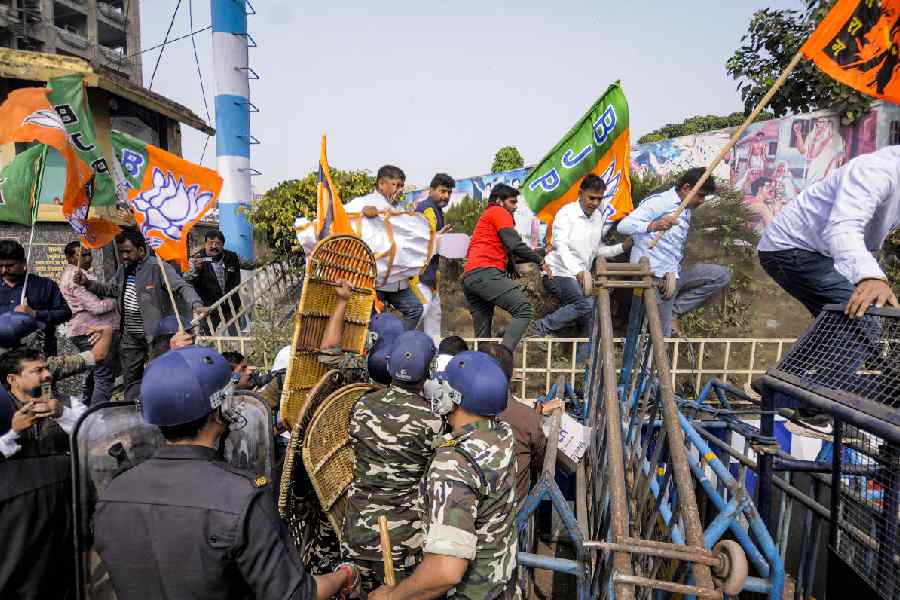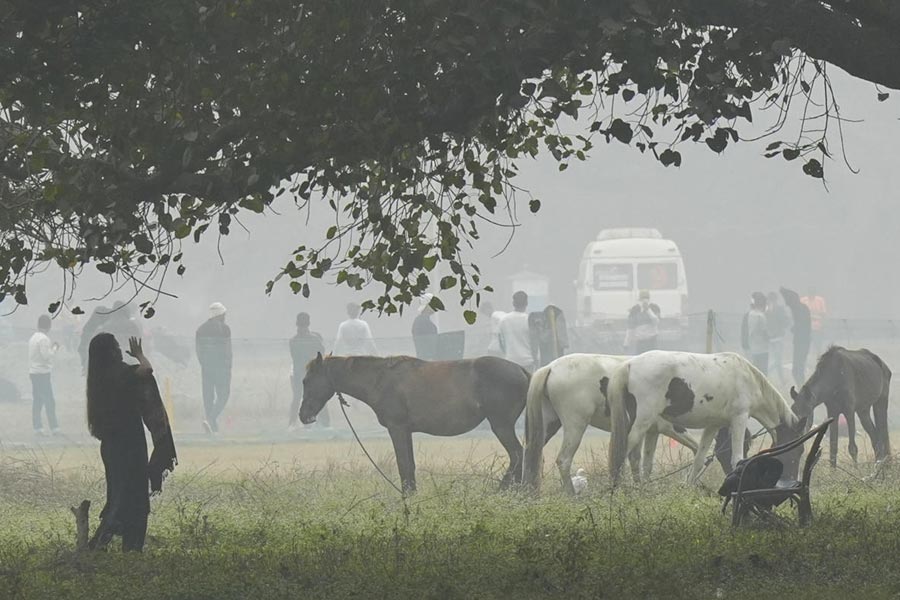
French consul-general Fabrice Etienne at the exhibition of Gaste’s works in ICCR. Picture by Bibhas Lodh
The songs that Rabindranath Tagore wrote were undoubtedly the best that Bengal could offer. Dwijendralal Roy, Atulprasad Sen, Rajanikanta Sen and Nazrul Islam were all good in their own way, but Rabindrasangeet was unsurpassable. There were other songwriters and music composers too, who wrote popular Bengali songs, including some for films, which have entertained Bengalis for generations but which run the risk of being forgotten for lack of proper documentation.
The first of Swapan Shome's four-part compendium of the compositions of these popular Bengali songwriters, titled Ganer Bhitor Diye and published by Dhruvapad, is about the compositions of 11 songwriters - Sourindra Mohan Mukhopadhyay, Hemendra Kumar Roy, Dhirendranath Mukhopadhyay, Dilip Kumar Roy, Tulsi Lahiri, Tarasankar Bandyopadhyay, Sajanikanta Das, Hiren Bose, Premendra Mitra, Shailen Roy and Ajay Bhattacharya.
Some of these songwriters were well-known litterateurs in their own right, like Tarasankar Bandyopadhyay, Premendra Mitra, Sajanikanta Das and Hemendra Kumar Roy of Abar Jakher Dhan fame. They wrote not only romantic compositions but also about the freedom struggle, the 1943 famine and everyday life situations. Tulsi Lahiri's songs of the famine, Bijoya and Agomani and others were sung by an emotionally charged Kamala Jharia. Uma Basu, M.S. Subbulakshmi, Manju Gupta and Sahana Debi sang Dilip Kumar Roy's compositions. Many of Tarasankar's compositions were written for film. Some compositions of Dhirendranath Mukhopadhyay are mistakenly attributed to Nazrul. All these songs are now available online.
There are similar books on Bengali songs written earlier. But in this volume all the information has been collated systematically, with everything from respective record numbers, year of issue and other relevant data. Swapan Shome plans to end the compendium with the songs of Suman Chattopadhyay.

A scene from the play Kanchan Rango, which was staged as part of a theatre festival organised by Nandiranga Natya Sangstha at Tapan Theatre. The festival was a tribute to Sambhu Mitra. Picture by Chanchal Ghosh
French connection
In 1905, a 36-year-old man landed in Agra in his quest to know 'the mystical land of the Indies'. He was seduced by Muslim India, which inspired his paintings throbbing with humanity. After voyages elsewhere, he returned to the country in 1908, this time to the south. He breathed his last in his Madurai studio on September 12, 1910.
More than a century later, Georges Gaste is being remembered in the land where he documented the people through his canvas and camera with so much sincerity. An exhibition of his photographs is being held at ICCR, in collaboration with Alliance Francaise du Bengale and the French embassy. The exhibition comprises 34 black-and-white photographs, which were digitised from glass plates.
Gaste was recognised as a prominent chronicler of the Orient back in his day. In 1906, his landscapes and portraits were displayed at the Salon des Orientalistes exhibition in Paris. In 1908, he achieved recognition at the year's Orientalist exhibition with many of his paintings getting sold and articles highlighting the mystique and the poetry of his portraits being published.
These are qualities that his photographs, taken in Madurai, Benaras, Agra and Delhi, possess as well.
In 1911, a retrospective of his works, organised at the salon, led to a 'catalogue raisonne' (a comprehensive, annotated listing). Gaste was honoured posthumously as the Indies Painter. In 1913, another retrospective was held at the Grand Palais, showing his Indian works in particular.
Introducing his work to viewers gathered at the inauguration, French consul-general Fabrice Etienne said: 'Gaste did not subscribe to the general view of India as a land of mythology and fantasy. He was an artist with a wild and passionate temperament. He lived the East to the full, painting and taking photographs to document the lives of the people he met.'
The travelling exhibition will continue till March 24. Calcutta is the ninth Indian city it has travelled to.

Speakers on the creatively done-up stage at the SNDMA programme. Picture by Sayantan Ghosh
Kantha creativity
'I've never seen a stage like this! This is so good,' said Shashi Panja, state women and child development and social welfare minister, while addressing a gathering to celebrate 90 years of the Saroj Nalini Dutt Memorial Association (SNDMA) on Ballygunge Station Road. The stage in question was decorated with intricate nakshi kantha work on silk and cotton.
'I look forward to a long partnership between the government and Saroj Nalini Dutt Memorial Association soon. What moves me is Saroj Nalini's fight for women's employment and economic independence, issues that are so relevant even today,' the minister added.
SNDMA was set up in 1925 by Gurusaday Dutt in memory of his wife Saroj, who was moved by the plight of women in rural Bengal. Born on October 9, 1887, Saroj started Mahila Samity in undivided Bengal with just four women, to show them the path to economic independence. Soon the number grew. At present there are 600 beneficiaries.
In 1920, Saroj, along with her husband, started Suri Mahila Samity, which now functions as SNDMA's headquarters. She passed away on January 19, 1925. After the death of Gurusaday Dutt, his daughter-in-law Aroti took over the baton of the organisation, till her death in 2003.
The trust runs various centres like the kantha centre that manufactures embroidered saris, stoles, dupattas, tea cozy sets, quilts and more. The trust also runs 24 branches of the Mahila Samity in different locations, like Birbhum, Sultanpur and Rampurhat, among other activities.
Ruth Shanks AM, world president, Associated Country Women of The World, was a guest at the event. 'There has been a strong relationship between the two organisations. It is difficult to mobilise rural women. But SNDMA has managed to it. I hope to be here for the centenary celebrations as well,' she said.

A flower show organised by the Pushpa Bitan Friendship Society at Jyotirmai Club in Garcha. There was also music and songs by Parul Swarup as part of the event. Picture by B. Halder
Organic market
Earth Day Network organised a day-long Go Organic Garden Party at the Jalan House gardens in New Alipore recently. This is part of the NGO's Go Organic initiative that was launched in January 2013.
'We have come a long way since our launch. We have organised so many organic-focused events. A clientele for organic products is growing, as is the awareness about the benefits of going organic,' said Karuna Singh, Earth Day Network India director.
Several stalls were set up selling organic products like groceries, green vegetables, clothing, lifestyle products and skin and haircare items.
Chef Shaun Kenworthy set up a salad and pasta counter while Rajah Banerjee of Makaibari Tea Estates talked about sustainable living. NGOs like Apne Aap Women Worldwide, Artisana of the Crafts Council of West Bengal and others also set up stalls.
(Contributed by Soumitra Das, Sudeshna Banerjee and Showli Chakraborty)










